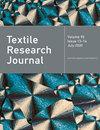Carbon footprint calculation and evaluation of mulberry silk quilts
IF 1.9
4区 工程技术
Q2 MATERIALS SCIENCE, TEXTILES
引用次数: 0
Abstract
At present, there is growing concern with climate change and environmental impacts arising from textiles. The carbon footprint measures the total amount of greenhouse gas emissions generated directly and indirectly by human activities. Among silk home textiles, mulberry silk quilts occupy a significant proportion, but there has been no carbon footprint accounting for silk quilt products. In order to identify the key emission processes during the production of mulberry silk quilts and further explore the improvement opportunities, this study calculated and evaluated the carbon footprints of mulberry silk quilts with nine specifications. The results showed that the carbon footprint result was influenced by product weight and size. The larger the size and weight of the product, the larger the carbon footprint result would be. By examining the carbon footprint of a representative piece of mulberry silk quilt (1 kg, 180 cm × 220 cm) throughout the production process, the study found that the carbon footprint result was concentrated in the white silk yarn production stage, exceeding 44.87%. Further, steam was the largest emission source of the carbon footprint, at over 39.56%. In addition, this study compared and analyzed the differences between fresh and dry cocoon reeling technologies. In terms of carbon footprint, the dry cocoon reeling technology produces a larger carbon footprint than the fresh cocoon reeling technology for the same weight of white silk. The findings in this study provide valuable insights into the greenhouse effect impact of mulberry silk quilt production and contribute to sustainable manufacturing practices in the silk industry.桑蚕丝被的碳足迹计算与评估
目前,人们越来越关注气候变化和纺织品对环境的影响。碳足迹衡量的是人类活动直接和间接产生的温室气体排放总量。在丝绸家用纺织品中,桑蚕丝被占有相当大的比重,但目前还没有针对蚕丝被产品的碳足迹核算。为了确定桑蚕丝被生产过程中的关键排放环节,进一步探索改进机会,本研究计算并评估了九种规格桑蚕丝被的碳足迹。结果表明,碳足迹结果受产品重量和尺寸的影响。产品的尺寸和重量越大,碳足迹结果就越大。通过研究具有代表性的桑蚕丝被(1 千克,180 厘米×220 厘米)在整个生产过程中的碳足迹,研究发现碳足迹结果集中在白蚕丝生产阶段,超过 44.87%。此外,蒸汽是碳足迹的最大排放源,超过 39.56%。此外,本研究还比较分析了鲜茧和干茧缫丝技术之间的差异。就碳足迹而言,在白丝重量相同的情况下,干茧缫丝技术产生的碳足迹大于鲜茧缫丝技术。这项研究的结果为了解桑蚕丝被生产对温室效应的影响提供了宝贵的见解,有助于丝绸业的可持续生产实践。
本文章由计算机程序翻译,如有差异,请以英文原文为准。
求助全文
约1分钟内获得全文
求助全文
来源期刊

Textile Research Journal
工程技术-材料科学:纺织
CiteScore
4.00
自引率
21.70%
发文量
309
审稿时长
1.5 months
期刊介绍:
The Textile Research Journal is the leading peer reviewed Journal for textile research. It is devoted to the dissemination of fundamental, theoretical and applied scientific knowledge in materials, chemistry, manufacture and system sciences related to fibers, fibrous assemblies and textiles. The Journal serves authors and subscribers worldwide, and it is selective in accepting contributions on the basis of merit, novelty and originality.
 求助内容:
求助内容: 应助结果提醒方式:
应助结果提醒方式:


